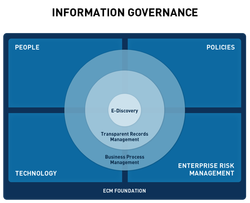
What needs to be considered in information governance polices?
Government mandates - If you are in a regulated industry, you need to consider first and foremost government mandates such as GMP/GxP, ISO 9001. You need to make sure that your documents management and IT are compliant with these requirements.
Proliferation of content - there has been explosive growth in the creation and collection of content by organization and individuals. Content is stored in CMS, data warehouses, physical warehouses, desktop computers, file shares, back-up archives, mobile devices, cloud services, employees personal computers and other devices such as tablets, smart phones, etc. To complicate matters this information is also geographically disbursed.
In SharePoint, for example, you get a small department that has a site, other departments take notice and start their own sites. Suddenly you have small SharePoint instances pervading everywhere. What organization should do instead is take those separate silos of SharePoint and combine them into one centrally managed environment. It is the matter of having a plan in place first, then applying the technology to achieve those business goals.
Information governance policies should cover desktops and shared drives, CMSs, databases and data warehouses, email systems, cloud based apps, social media platforms, physical warehouses. Content may be stored with the 3rd party, this needs to be considered.
Employees send email with documents attachments. This email and attachments have significant value to the business whether they contain contract terms, meeting notes or even employees opinions on a given topic. Email requires governance and so it needs to be included in your information governance policies.
Big data – are you prepared? What measures your IT has taken to help with this issue?
Cloud computing – If you use cloud computing, you need to create governance policy for it.
Mobile Devices - Employees use mobile devices to do their job. Many companies don’t have policies that cover things like tablets and handhelds. They are starting to, but it is just a beginning. You need to create polices for mobile devices and a mechanism to enforce those policies. And in the regulated environment, you would need to prove that you are enforcing those policies.
Social media - effectively leveraging social media while protecting the organization from non-compliance.
Create comprehensive social media governance plan. It should include compliance, supervision to interactive social content; perform conceptual search and policy-based monitoring of all info, inside and outside the firewall; establish social media usage policies and procedures and then train staff on them; preserve and collect relevant social media content for compliance and litigation purposes.
Consider all content and access methods involved as users connect via smartphones and tablets.
Employ solutions that capture additional approval on a site-by-site basis to verify assent for capturing and monitoring.
Wherever possible create separate business identities for social media to minimize capture of personal or private information.
Govern employees interactions. Most regulated organizations are taking a measured approach to social media, starting with small number of employees and approved social media sites.
Monitor and capture inside-based interactions within a corporate networks. Moderate inside-based interactions. Be mindful of legal and regulatory guidelines.
BYOD phenomena – “bring your own device”. People bring their iPads, iPhones, etc. to conferences, work, taking notes, making presentations, responding to email, updating pipeline,etc. All this content belongs to the organization but the device is not. What happens when this employee leaves the company? Or that employee loses the tablet? What happens to information?
I read about the case where a doctor had all his patients’ medical records unencrypted on his laptop. The laptop was stolen.
It could also be that there are multiple versions of documents floating around, gets passed from one person to another person, maybe tweaked a little along the way. And they each are legally discoverable.
Be sure that the official version of the document is stored in your CMS and managed by your governance program.
It is imperative to have a policy to protect this information and to enforce that policy across all those devices.
Security – sensitive information must be protected – encrypted. LinkedIn got hacked and all passwords got stolen. What are you going to do that this does not happen to your organization?
Intellectual property - What about a pharmaceutical company developing a new drug, not yet under patent protection, and an employee takes that information to a competitor?
Of special importance is information related to future revenue. For example, a pharmaceutical company should place a high priority on protecting information related to future products which are not covered by patents.
It is vital for companies to have a system in place to protect sensitive content such as for example product roadmaps, manufacturing plans, vendor supply lists, marketing and promotional strategies.
In my next post, I will describe information governance for crisis management and e-discovery.
 RSS Feed
RSS Feed
